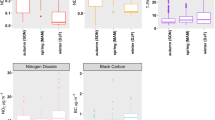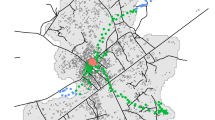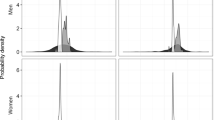Abstract
Air pollution exposure and places where the exposures occur may differ in cities in the developing world compared with high-income countries. Our aim was to measure personal fine particulate matter (PM2.5) exposure of students in neighborhoods of varying socioeconomic status in Accra, Ghana, and to quantify the main predictors of exposure. We measured 24-hour PM2.5 exposure of 56 students from eight schools in four neighborhoods. PM2.5 was measured both gravimetrically and continuously, with time-matched global positioning system coordinates. We collected data on determinants of exposure, such as distances of homes and schools from main roads and fuel used for cooking at their home or in the area of residence/school. The association of PM2.5 exposure with sources was estimated using linear mixed-effects models. Personal PM2.5 exposures ranged from less than 10 μg/m3 to more than 150 μg/m3 (mean 56 μg/m3). Girls had higher exposure than boys (67 vs 44 μg/m3; P-value=0.001). Exposure was inversely associated with distance of home or school to main roads, but the associations were not statistically significant in the multivariate model. Use of biomass fuels in the area where the school was located was also associated with higher exposure, as was household’s own biomass use. Paved schoolyard surface was associated with lower exposure. School locations in relation to major roads, materials of school ground surfaces, and biomass use in the area around schools may be important determinants of air pollution exposure.
This is a preview of subscription content, access via your institution
Access options
Subscribe to this journal
Receive 6 print issues and online access
$259.00 per year
only $43.17 per issue
Buy this article
- Purchase on Springer Link
- Instant access to full article PDF
Prices may be subject to local taxes which are calculated during checkout





Similar content being viewed by others
References
Lim SS, Vos T, Flaxman AD, Danaei G, Shibuya K, Adair-Rohani H et al. A comparative risk assessment of burden of disease and injury attributable to 67 risk factors and risk factor clusters in 21 regions, 1990–2010: a systematic analysis for the Global Burden of Disease Study 2010. Lancet 2012: 380: 2224–2260.
Brauer M, Amann M, Burnett RT, Cohen A, Dentener F, Ezzati M et al. Exposure assessment for estimation of the global burden of disease attributable to outdoor air pollution. Environ Sci Technol 2012: 46: 652–660.
Arku RE, Vallarino J, Dionisio KL, Willis R, Choi H, Wilson JG et al. Characterizing air pollution in two low-income neighborhoods in Accra, Ghana. Sci Total Environ 2008: 402: 217–231.
Dionisio KL, Arku RE, Hughes AF, Vallarino J, Carmichael H, Spengler JD et al. Air pollution in Accra neighborhoods: spatial, socioeconomic, and temporal patterns. Environ Sci Technol 2010: 44: 2270–2276.
Dionisio KL, Rooney MS, Arku RE, Friedman AB, Hughes AF, Vallarino J et al. Within-neighborhood patterns and sources of particle pollution: mobile monitoring and geographic information system analysis in four communities in Accra, Ghana. Environ Health Perspect 2010: 118: 607–613.
Padhi BK, Padhy PK Assessment of intra-urban variability in outdoor air quality and its health risks. Inhal Toxicol. 2008: 20: 973–979.
van Vliet E, Kinney P Impacts of roadway emissions on urban particulate matter concentrations in sub-Saharan Africa: new evidence from Nairobi, Kenya. Environ Res Lett 2007; 2: 045028.
Rooney MS, Arku RE, Dionisio KL, Paciorek C, Friedman AB, Carmichael H et al. Spatial and temporal patterns of particulate matter sources and pollution in four communities in Accra, Ghana. Sci Total Environ 2012: 435-436: 107–114.
Etyemezian V, Tesfaye M, Yimer A, Chow JC, Mesfin D, Nega T et al. Results from a pilot-scale air quality study in Addis Ababa, Ethiopia. Atmos Environ 2005: 39: 7849–7860.
Zhou Z, Dionisio KL, Verissimo TG, Kerr AS, Coull B, Arku RE et al. Chemical composition and sources of particle pollution in affluent and poor neighborhoods of Accra, Ghana. Environ Res Lett 2013: 8: 044025.
Bailis R, Ezzati M, Kammen DM Mortality and greenhouse gas impacts of biomass and petroleum energy futures in Africa. Science 2005: 308: 98–103.
Bonjour S, Adair-Rohani H, Wolf J, Bruce NG, Mehta S, Pruss-Ustun A et al. Solid fuel use for household cooking: country and regional estimates for 1980-2010. Environ Health Perspect 2013: 121: 784–790.
Zhou Z, Dionisio KL, Arku RE, Quaye A, Hughes AF, Vallarino J et al. Household and community poverty, biomass use, and air pollution in Accra, Ghana. Proc Natl Acad Sci USA 2011: 108: 11028–11033.
van Roosbroeck S, Wichmann J, Janssen NA, Hoek G, van Wijnen JH, Lebret E et al. Long-term personal exposure to traffic-related air pollution among school children, a validation study. Sci Total Environ 2006: 368: 565–573.
Borgini A, Tittarelli A, Ricci C, Bertoldi M, De Saeger E, Crosignani P Personal exposure to PM2.5 among high-school students in Milan and background measurements: the EuroLifeNet study. Atmos Environ 2011 8// 45: 4147–4151.
Spira-Cohen A, Chen LC, Kendall M, Lall R, Thurston GD Personal exposures to traffic-related air pollution and acute respiratory health among Bronx schoolchildren with asthma. Environ Health Perspect 2011: 119: 559–565.
Spira-Cohen A, Chen LC, Kendall M, Sheesley R, Thurston GD Personal exposures to traffic-related particle pollution among children with asthma in the South Bronx, NY. J Expo Sci Environ Epidemiol 2010: 20: 446–456.
Crist KC, Liu B, Kim M, Deshpande SR, John K Characterization of fine particulate matter in Ohio: indoor, outdoor, and personal exposures. Environ Res 2008: 106: 62–71.
Du X, Kong Q, Ge W, Zhang S, Fu L . Characterization of personal exposure concentration of fine particles for adults and children exposed to high ambient concentrations in Beijing, China. J Environ Sci 2010; 22: 1757–1764.
Jiang R, Bell ML A comparison of particulate matter from biomass-burning rural and non-biomass-burning urban households in northeastern China. Environ Health Perspect 2008: 116: 907–914.
Ezzati M, Saleh H, Kammen DM The contributions of emissions and spatial microenvironments to exposure to indoor air pollution from biomass combustion in Kenya. Environ Health Perspect 2000: 108: 833–839.
Dionisio KL, Howie SR, Dominici F, Fornace KM, Spengler JD, Adegbola RA et al. Household concentrations and exposure of children to particulate matter from biomass fuels in The Gambia. Environ Sci Technol 2012: 46: 3519–3527.
Kistnasamy EJ, Robins TG, Naidoo RN, Batterman S, Mentz GB, Jack C et al. The relationship between asthma and ambient air pollutants among primary school students in Durban, South Africa. Int J Environ Health 2008; 2: 365–385.
Naidoo RN, Robins TG, Batterman S, Mentz G, Jack C Ambient pollution and respiratory outcomes among schoolchildren in Durban, South Africa. S Afr J Child Health 2013: 7: 127–134.
United Nations Department of Economic and Social Affairs (Population Division) 2011.
World Health Organization Global Status Report on Noncommunicable Diseases 2010. World Health Organization (WHO): Geneva, 2011).
Demokritou P, Kavouras IG, Ferguson ST, Koutrakis P Development and laboratory performance evaluation of a personal multipollutant sampler for simultaneous measurements of particulate and gaseous pollutants. Aerosol Sci Technol 2001 2001/01/01 35: 741–752.
Chakrabarti B, Fine P, Delfino R, Sioutas C Performance evaluation of an active personal DataRAM PM2.5 Mass Monitor (Thermo Anderson pDR-1200) designed for continuous personal exposure measurements. Atmos Environ 2004: 38: 3329–3340.
Laird NM, Ware JH Random-effects models for longitudinal data. Biometrics 1982: 38: 963–974.
WHO Air quality guidelines for particulate matter, ozone, nitrogen dioxide and sulfur dioxide. 2005.
Wu C-F, Delfino RJ, Floro JN, Quintana PJE, Samimi BS, Kleinman MT et al. Exposure assessment and modeling of particulate matter for asthmatic children using personal nephelometers. Atmos Environ 2005; 39: 3457–3469.
Van Roosbroeck S, Jacobs J, Janssen NAH, Oldenwening M, Hoek G, Brunekreef B . Long-term personal exposure to PM2.5, soot and NOx in children attending schools located near busy roads, a validation study. Atmos Environ 2007; 41: 3381–3394.
Amram O, Abernethy R, Brauer M, Davies H, Allen RW Proximity of public elementary schools to major roads in Canadian urban areas. Int J Health Geogr 2011: 10: 68.
Nakagawa S, Schielzeth H A general and simple method for obtaining R2 from generalized linear mixed-effects models. Methods Ecol Evol 2013: 4: 133–142.
Acknowledgements
ME is supported by a UK MRC Strategic Award.
Author information
Authors and Affiliations
Corresponding author
Ethics declarations
Competing interests
The authors declare no conflict of interest.
Rights and permissions
About this article
Cite this article
Arku, R., Dionisio, K., Hughes, A. et al. Personal particulate matter exposures and locations of students in four neighborhoods in Accra, Ghana. J Expo Sci Environ Epidemiol 25, 557–566 (2015). https://doi.org/10.1038/jes.2014.56
Received:
Accepted:
Published:
Issue Date:
DOI: https://doi.org/10.1038/jes.2014.56
Keywords
This article is cited by
-
Characterisation of urban environment and activity across space and time using street images and deep learning in Accra
Scientific Reports (2022)
-
Solid fuel use and early child development disparities in Ghana: analyses by gender and urbanicity
Journal of Exposure Science & Environmental Epidemiology (2020)



